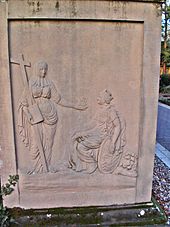Maximilian Joseph Pozzi



Maximilian Joseph Maria Pozzi , also Massimiliano Giuseppe Maria Pozzi (* July 2, 1770 in Mannheim ; † March 12, 1842 ibid) was a German sculptor of Italian-Swiss descent, from the Pozzi family of artists .
biography
Maximilian Joseph Pozzi was the son of from Bruzella immigrant Palatine and Baden Hofstuckateurs Joseph Anton Pozzi was born (1732-1811) in Mannheim and attended until his 16th birthday, the local Jesuit school. He received his first artistic training from his father and accompanied him to Frankfurt am Main in 1789 , to decorate the newly built palace of the banker Franz Maria Schweitzer .
From 1790 the young man attended the art academy in his hometown and learned sculpture. As early as 1793 he was awarded the great gold medal for his work. In 1799 Pozzi went to Munich, where he created an image of the new Elector Maximilian IV Joseph . He became known at court and received some good commissions there. Soon after the death of the academy director Peter Anton von Verschaffelt , in 1793, the Mannheim drawing academy began to decline . Returning to Mannheim, Pozzi as secretary and the painter Carl Kuntz as director tried to revive the academy again in 1802/1803, but this failed. Maximilian Joseph Pozzi restored the market square fountain, which was damaged in the bombardment of Mannheim in 1795, and in 1804, at the request of Prince Joseph II zu Schwarzenberg , made an elaborate marble tomb for his brother Friedrich Johann Nepomuk zu Schwarzenberg , which is now in the parish church of St. Laurentius zu Weinheim is located. In 1805 Pozzi received the order from the Grand Duke of Baden to carry out the gable reliefs at Ettlinger Tor in Karlsruhe (demolished in 1872). After its completion, he appointed him professor of sculpture, and in 1809 the grand ducal court sculptor of Baden .
From then on, Pozzi lived as a regionally important sculptor in Mannheim and worked here and in the surrounding area, especially creating very high quality grave monuments. When the poet August von Kotzebue was murdered in Mannheim in 1819, Pozzi took his death mask from him, made a bust from it and also used the facial features in two theatrical masks on the tomb of the poet he created in the main cemetery in Mannheim . In 1833 the sculptor was one of the founders of the Mannheim Art Association ; Due to illness he could no longer work from 1836. At times his nephew Antonio Pozzi, who was also a sculptor, worked in his workshop, but he died in 1829.
From 1805 Maximilian Joseph Pozzi was married to Klara von Reibeld, who died in 1834. The marriage resulted in 2 children. The son Giacomo Pozzi (1814–1897) became known as a painter and lithographer .
Works by Maximilian Joseph Pozzi
Tomb for August von Kotzebue , Mannheim main cemetery
Grave monument for Georg von Stengel , Mannheim main cemetery
Tomb for Christian Philipp Stumm , Mannheim main cemetery
literature
- Ludwig Nieser: Pozzi, Maximilian . In: Allgemeine Deutsche Biographie (ADB). Volume 26, Duncker & Humblot, Leipzig 1888, p. 497 f.
- Friedrich August Schmidt: New Nekrolog der Deutschen , twentieth year, 1842, 1st part, Weimar 1844, pages 243 and 244; Scan from the source
Web links
- Genealogical website on Maximilian Joseph Pozzi
- PDF document on St. Peter's Church in Heidelberg, with classicist tombstones attributed to Maximilian Joseph Pozzi
Individual evidence
- ^ Anastasia Gilardi: Pozzi. In: Historical Lexicon of Switzerland . 2010 .
- ↑ Website of the Mannheim Drawing Academy
- ^ Bénédicte Savoy: Temple of Art: The Birth of the Public Museum in Germany 1701-1815 , 2006, ISBN 3805336373 , pages 246 and 252; Excerpts from the source
- ^ Hans Huth: Die Kunstdenkmäler des Stadtkreis Mannheim , Volume 2, Deutscher Kunstverlag, 1982, Page 1364, ISBN 3422005560 ; Excerpt from the source
- ^ Kath. Pfarramt Weinheim: Church guide St. Laurentius Weinheim , 2002, page 21
- ↑ The historic Ettlinger Tor in Karlsruhe Wiki
- ↑ Baden Government Gazette, No. 29, Karlsruhe, September 17, 1808; Scan from the source
- ^ Genealogical page on Antonio Pozzi
| personal data | |
|---|---|
| SURNAME | Pozzi, Maximilian Joseph |
| ALTERNATIVE NAMES | Pozzi, Maximilian Joseph Maria; Pozzi, Massimiliano Giuseppe Maria |
| BRIEF DESCRIPTION | German sculptor |
| DATE OF BIRTH | July 2, 1770 |
| PLACE OF BIRTH | Mannheim |
| DATE OF DEATH | March 12, 1842 |
| Place of death | Mannheim |



